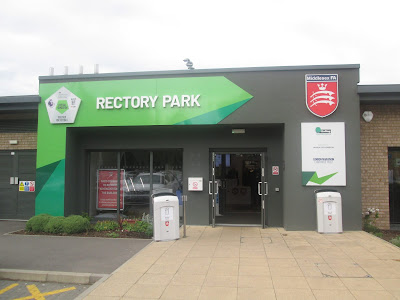Kensington & Ealing Borough 1 St Panteleimon 3 - Middlesex Premier Cup Final
The Middlesex Football Association was founded in 1883 by the Football Association. Nicholas Lane Jackson, who had helped found the Corinthians in 1882, organised the founding of the association, and became its first chairman. The association left the Football Association in 1907 to join the Amateur Football Association, but it soon returned. It moved to its previous headquarters at Roxborough Road in Harrow in 1975. It did not employ any full-time staff until 1992. The Middlesex F.A. covers the historic extent of Middlesex and the entirety of the boroughs of Richmond upon Thames and Barnet. This area overlaps with the scope of the London Football Association, the Surrey County Football Association and Hertfordshire County Football Association. This means that many clubs are eligible for affiliation with more than one county football association.
Rectory Park has been the home of the Middlesex Football Association since 2018. The purpose built venue boasts two first class floodlit 3G football pitches, 120 square metres of community space available for function bookings, Executive meeting rooms, Cafe / Bar area, and Free Parking. Our QPR and TFL correspondent, Chris Hewitt, advises the following public transport option "if going to tube to Northolt, cross the road from station on left, take bus 120 or 282 drops you outside Rectory Park - takes 10 minutes to Wayfarer Road stop".
The Middlesex FA Premier Cup is open to Second or Under 21 teams of Senior Clubs, First Teams of Clubs playing at Steps 6 and 7 of the National League System and other teams approved by the Committee. The competition was introduced in 1980 with the first winners being Yeading FC. The current season saw seventeen clubs enter the competition, with the finalists each winning three matches to reach this stage.
The Much Travelled Adam Carne described this venue as uninspiring and I can see what he means. The facility could also be described as functional, in that it lacks the personal charm of some club venues. Effectively, the main pitch and that adjacent to it, are housed in cages. The main pitch has additional spectator facilities in the shape of two identical covered seated stands. These stands are situated along the only side of the pitch that spectators have access too. Toilets and a rather smart refreshment café are located in the main clubhouse building and serve the entire complex.
Admission to the match was by ticket only and I suspect that a number of those disappointed at the quick take up of the 150 tickets made available, turned up and were able to watch the match through the fence. They witnessed a lively and often feisty match which saw a first half dismissal (two yellow cards) for a Kensington player. St Panteleimon missed an early penalty before eventually taking the lead.
Despite the reduction in their
numbers, Kennington were themselves awarded a penalty which was duly converted
and you could see that the second period was still going to be highly
competitive. The referee was kept busy all night and further yellow cards were
produced at regular intervals. As the match wore on, St Panteleimon were applying greater pressure
and this told when they took the lead curtesy of an unfortunate own goal. A
further strike clinched the cup for St Panteleimon, on a ground where they had
played a few home fixtures in recent times.
It was good to witness such a
competitive match as the month of May reaches a conclusion. I should also
mention the sighting of a red kite over the ground before the match, thus
continuing a recent theme. The journey home via the North Circular and A10
(thanks Phil) was swift, more pleasant and much quicker than the public transport alternative.









No comments:
Post a Comment